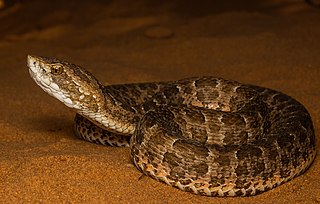
Psidium is a genus of trees and shrubs in the family Myrtaceae. It is native to warmer parts of the Western Hemisphere.

Vital Brazil Mineiro da Campanha, known as Vital Brazil, was a Brazilian physician, biomedical scientist and immunologist, known for the discovery of the polyvalent anti-ophidic serum used to treat bites of venomous snakes of the Crotalus, Bothrops and Elaps genera. He went on to be also the first to develop anti-scorpion and anti-spider serums. He was the founder of the Butantan Institute, a research center located in São Paulo, which was the first in the world dedicated exclusively to basic and applied toxicology, the science of venomous animals.

Amerotyphlops brongersmianus, known commonly as Brongersma's worm snake or the South American striped blindsnake, is a species of harmless blind snake in the family Typhlopidae. The species is native to South America and Trinidad and Tobago in the Caribbean. No subspecies are currently recognized.

Manihot is a genus in the diverse milkspurge family, Euphorbiaceae. It was described as a genus in 1754.

Bothrops jararaca — known as the jararaca or yarara — is a highly venomous pit viper species endemic to South America in southern Brazil, Paraguay, and northern Argentina. The specific name, jararaca, is derived from the Tupi words yarará and ca, which mean "large snake". Within its geographic range, it is often abundant and is an important cause of snakebite. No subspecies are currently recognized.

Dyckia is a genus of plants in the family Bromeliaceae, subfamily Pitcairnioideae.

The dwarf tinamou also known as the least tinamou, is a small, superficially partridge-like bird with short tail and wings.

Corallus cropanii, or Cropani's tree boa, is a species of boa, a snake in the family Boidae. The species is endemic to the state of São Paulo, Brazil. Like all boas, it is not venomous. No subspecies are currently recognized. Until 2017, no specimen of this snake had been seen alive since 1953 and only five dead specimens had been collected since then, but in late January 2017, an adult female Cropan's tree boa measuring 1.7 m was captured by locals in Ribeira who brought it to herpetologists from the Instituto Butantan and the Museum of Zoology of the University of São Paulo, who radio-tagged and released the animal to learn more about the species' behavior.

Syngonanthus is a genus of plant in family Eriocaulaceae. It is native to tropical Africa and to Latin America.

Bothrops brazili is a venomous pitviper species endemic to South America. There are no subspecies that are recognized as being valid.

Austroeupatorium is a genus of plants native primarily to South America, including herbaceous perennials and shrubs. The native range is focused on eastern South America and extends as far north as Panama and Trinidad and as far west as Bolivia.
Agenium is a genus of South American plants in the grass family.

Bothrops fonsecai, also known commonly as Fonseca's lancehead, is a species of venomous snake in the family Viperidae. The species is endemic to Brazil.

Bothrops itapetiningae, or the São Paulo lancehead, is a species of venomous snake in the family Viperidae. It is endemic to Brazil.
Liotyphlops schubarti is a species of snake in the family Anomalepididae. The species is endemic to Brazil.
Liotyphlops wilderi is a species of snake in the family Anomalepididae. The species is endemic to Brazil.

Amaral's blind snake is a species of snake in the family Leptotyphlopidae. The species is native to South America.
The Espírito Santo blind snake is a species of snake in the family Leptotyphlopidae. The species is endemic to Brazil.

Papilio astyalus, the broad-banded swallowtail or Astyalus swallowtail, is a butterfly of the family Papilionidae. It is found from Mexico south to Argentina. It is occasionally reported from southern Texas and rare strays can be found up to southern Arizona and northern Texas.

Parides bunichus is a butterfly of the family Papilionidae. It is found in Brazil, Paraguay, Argentina and Uruguay.

















